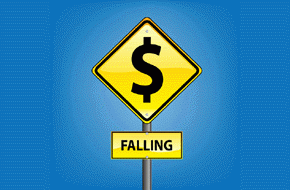
The New Zealand dollar ended the week sharply lower.
It ended trading in New York at NZ$1 - US$0.7940, its lowest closing level since July 26, 2012.
It started the month at NZ$1 = US$0.8569 and today's fall represents a decline of 7.3%.
The TWI ended the week at 74.89, down 4.7% from its May high.
According to data published by the RBNZ yesterday, the average exchange rate for May 2013 was NZ$1 = US$0.8266 and the average TWI for the month was 77.30.
It fell as markets absorbed RBNZ Governor Wheeler's recent comments, and on general weakness by commodity-linked currencies. The Aussie also fell and ended its trading at AU$1 = US$0.9570.
Commodity-linked currencies fell because some key commodities fell in US dollar prices.
Oil was down sharply, and gold fell back below US$1,400/ox.
WTI oil fell to US$91.63/barrel, a drop of US$3.50 on the day, and it is now at its lowest level since the start of May. Brent crude dropped a similar amount and is now sitting just over US$100/barrel.
Gold fell to US$1,394.50/oz in London, and fell further in New York, closing at US$1,387.60.
Copper and aluminium rose however.
The yen rose after Japan reported accelerating factory output and ebbing deflation.
But data out from Europe was weak, and US markets are worried about the end of their stimulus program.
Credit markets were unsettled too, with CDS spreads rising across the board. Credit markets are more concerned about Japan than the currency markets are. Japanese sovereign CDS spreads rose to 76.15 bps, a rise of 40% from mid-month.
No chart with that title exists.
6 Comments
We may wish to observe a minute's silence in memory of those unhedged foreign owners of New Zealand government debt
Let's hope, unlike the forex traders, they don't lose their nerve and sell to the buyers of last resort - NZ fund managers, thus crowding out the investment dollars that otherwise would be available for other asset classes.
Listen to the chatter
steven you just might be right this time - yesterday it gathered speed
The SPI200 (future) (ASX24) follows the underlying ASX200 physical index. After 4:00 pm AEST it follows the Iress synthetic XJO.DFS calculation during the closing cspa which occurs at 4:10 pm. Everything was orderly and under control until the final match out at 4:10 pm. ASX200 fell 18 points in the final print. Then the rout started. The SPI200 fell 50 points in 30 seconds. One single large institution must have dumped a lot of stock in the final seconds just before the match-out. Couldn't have been more than one institution unless it was by arrangement. 7 Hours before NY opened. (have never seen that savagery before)
Overnight NY fell 209 points on a range of 277 points
insider trading instruction manual
US and SEC regulatory controls on insider trading, in the US, do not apply in Australia. Most large trading houses in Australia are branches of major US trading houses. Australian regulatory controls on insider trading do not apply to futures trading. At all. See regulatory insider trading controls in the Australian market
Regulatory conditions are conducive to the following. The Australian Futures market tracks NY overnight (Australian time). During the opening session the following day (Australian time) the ASX200 will react to any overnight moves in the Dow and catch up with the SPI200 (ASX 24).
Knowing the AU market tracks the US market, instruments outside the jurisdiction of the SEC are very attractive to the US Westcoasters. If a major US institution is aware of an event that could have an affect on the DOW, which cannot be taken advantage of in the US, it is possible to take positions in the Australian Futures market, one day, and exit the following day, on the open.
Unlike Norman Parker and Ganesh Banana say, we did not have to print money to get from 0.84 to 0.79 vs US, just goes to show what economic numpties these clowns are.
Just ask youself, is NZ better off with English or Norman Parker as finance minister? If you say NP them you are absolute idiots.





We welcome your comments below. If you are not already registered, please register to comment.
Remember we welcome robust, respectful and insightful debate. We don't welcome abusive or defamatory comments and will de-register those repeatedly making such comments. Our current comment policy is here.